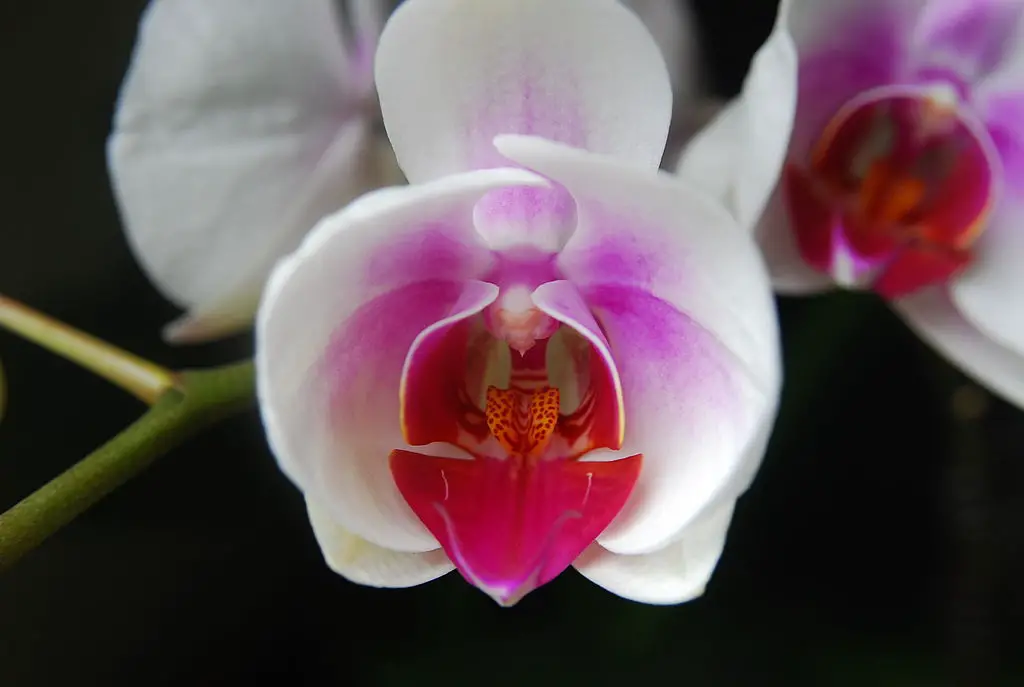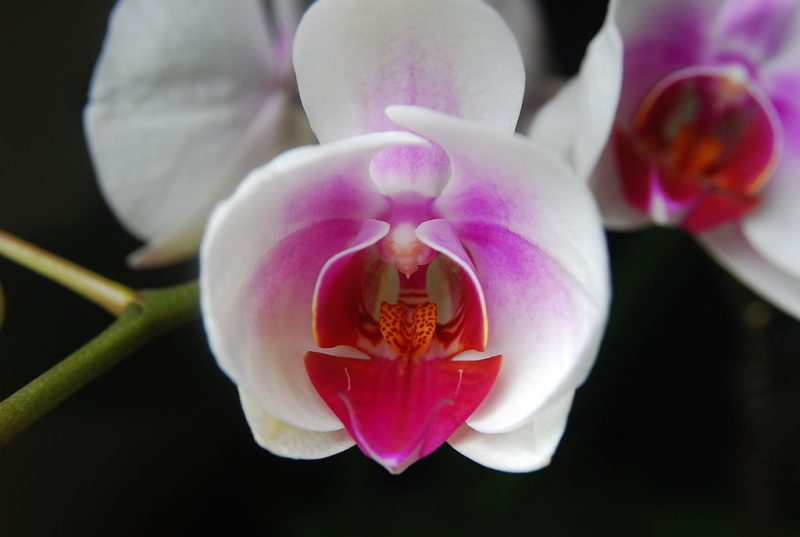
Dive into the world of Phalaenopsis orchid care with a simple guide to nurturing your moth orchid for year-round blooms.
Phalaenopsis Orchid Care Key Takeaways:
- Phalaenopsis orchid care involves bright, indirect light, weekly watering, and maintaining humidity at 50-70%.
- Fertilize monthly during growth. After blooming, cut the spike to encourage re-flowering.
Welcome to the vibrant realm of Phalaenopsis orchid care, where the charm of moth orchids unfolds.
Their low maintenance and stunning blooms make them a beloved choice for indoor gardeners.
In this friendly guide, we’ll walk you through the essentials, ensuring your orchids flourish.
Red Phalaenopsis Orchid in White Ceramic Pot with Burlap Bow
Phalaenopsis Orchid Care Introduction
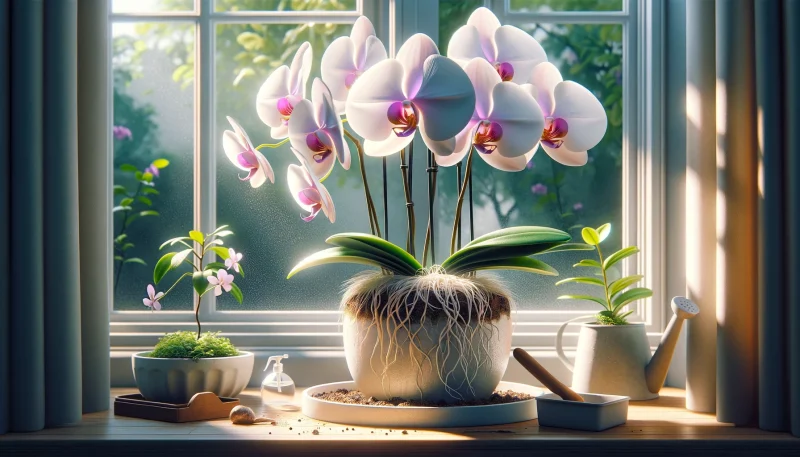
Phalaenopsis orchids, commonly known as moth orchids, are renowned for their elegant beauty and simplicity of care.
These captivating plants have gained immense popularity, making them a favorite among both novice and experienced gardeners.
In this guide, we’ll explore the essential aspects of Phalaenopsis orchid care, ensuring that these stunning blooms thrive in your indoor garden.
Overview of Phalaenopsis Orchids (Moth Orchids)
Phalaenopsis orchids, also known as moth orchids, are a popular choice for indoor gardeners due to their striking resemblance to moths in flight.
These orchids are native to tropical regions of Asia and Australia, where they grow as epiphytes, attaching themselves to trees and absorbing moisture and nutrients from the air.
With their broad, glossy leaves and long-lasting flowers that come in a variety of colors, Phalaenopsis orchids add a touch of elegance to any setting.
Popularity and Ease of Care
3″ Live Phalaenopsis Orchid Plants, Purple Blooms
One of the reasons for the widespread popularity of Phalaenopsis orchids is their ease of care, making them an ideal choice for beginners.
Unlike some other orchid species that require specific conditions, Phalaenopsis orchids thrive in typical home environments.
They prefer indirect light, moderate humidity, and consistent temperatures, all of which are easily achievable indoors.
Their resilience and ability to bloom for several months with minimal care have cemented their status as a favorite among houseplant enthusiasts.
Understanding Phalaenopsis Orchids
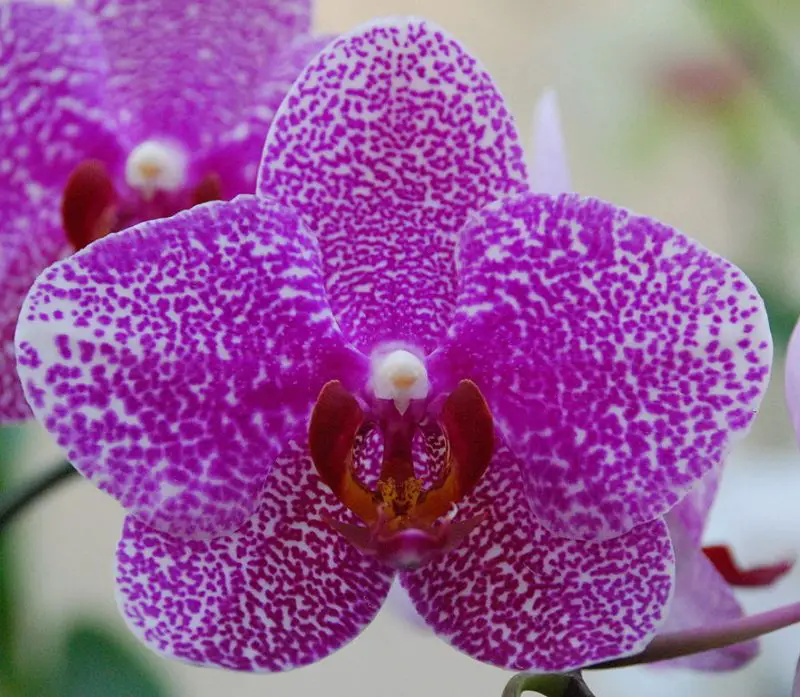
Phalaenopsis orchids, with their distinctive growth habits and stunning flowers, are a fascinating addition to any indoor garden.
In this section, we delve into the unique characteristics of these orchids, shedding light on their natural growth patterns and the captivating beauty of their blooms.
Growth Characteristics
Phalaenopsis orchids are epiphytic plants, meaning they grow on other plants or objects for support, rather than in soil.
In their natural habitat, they cling to tree trunks and branches, absorbing moisture and nutrients from the air.
Their roots are aerial and often extend beyond the pot, contributing to their distinctive appearance.
The leaves are broad and glossy, providing a lush backdrop for the flowers.
Flowering Patterns and Longevity
The flowers of Phalaenopsis orchids are renowned for their longevity, often lasting for several months.
They emerge from the leaf joints on long, arching spikes, and a single plant can produce multiple spikes.
The flowers come in a wide range of colors and patterns, adding a vibrant splash of color to any indoor space.
With proper care, these orchids can bloom multiple times a year, ensuring a continuous display of their enchanting beauty.
Proper Care for Phalaenopsis Orchids
2 Phalaenopsis, 3″ Pots, Purple and Light Pink Orchid Blooms
Ensuring the health and vitality of Phalaenopsis orchids involves understanding their specific care requirements.
This section will guide you through the essential aspects of watering, humidity, temperature, and light conditions, as well as providing support for their delicate flower stalks.
Watering Techniques and Frequency
Phalaenopsis orchids prefer a consistent watering schedule, typically once a week.
The key is to water thoroughly, allowing the water to run through the potting medium and out the bottom of the pot.
Avoid letting the orchid sit in water, as this can lead to root rot.
If the potting medium feels dry to the touch, it’s time to water. In warmer or drier conditions, you may need to water more frequently.
Importance of Humidity and How to Maintain It
These orchids thrive in environments with humidity levels between 50-70%.
To maintain adequate humidity, you can place the orchid on a tray filled with pebbles and water, ensuring that the pot is not sitting directly in the water.
Misting the orchid in the morning can also help increase humidity, but be cautious not to wet the flowers, as this can lead to fungal diseases.
Ideal Temperature and Light Conditions
Phalaenopsis orchids prefer temperatures between 65-80°F during the day and no lower than 60°F at night.
They thrive in indirect sunlight, so placing them near an east or west-facing window is ideal.
Direct sunlight can scorch their leaves, while too little light can hinder blooming.
If natural light is insufficient, consider using grow lights to supplement.
Staking Flower Stalks for Support
As the flower stalks of Phalaenopsis orchids grow, they may become top-heavy and require support.
Use a bamboo stake or similar support and gently tie the stalk to it with soft ties or clips.
This will prevent the stalk from bending or breaking, ensuring that your orchid displays its blooms beautifully.
Fertilizing and Re-flowering
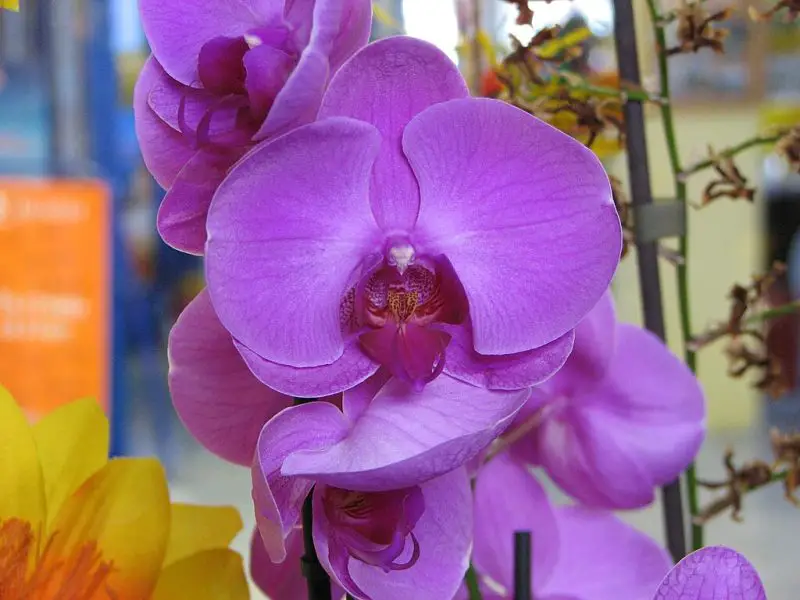
For Phalaenopsis orchids to thrive and bloom repeatedly, proper fertilization and care are essential.
In this section, we’ll explore how to nourish your orchids and encourage them to re-flower, ensuring a continuous display of their stunning blooms.
Fertilization Recommendations
Phalaenopsis orchids benefit from regular fertilization during their active growth and blooming periods.
Use a balanced orchid fertilizer (20-20-20 or similar) at half strength every other watering, or once a month.
It’s important to avoid over-fertilizing, as this can lead to salt buildup in the potting medium and damage the roots.
During the winter or when the orchid is not actively growing, reduce the frequency of fertilization.
Tips for Encouraging Re-flowering
- Light: Ensure your orchid receives adequate indirect light. If the leaves are dark green, they may need more light to initiate blooming.
- Temperature: Exposing the orchid to a slight drop in nighttime temperatures (about 10-15°F cooler than daytime) for a few weeks can trigger the formation of flower spikes.
- Watering: Maintain a consistent watering schedule, but allow the potting medium to dry slightly between waterings to avoid overwatering.
- Spike Care: After the flowers fade, you can cut the spike above a node to encourage a secondary bloom. If the spike turns brown, cut it back to the base.
- Rest Period: Allow your orchid to rest for a few months after blooming by reducing watering and fertilization. This rest period is crucial for the plant to gather energy for the next flowering cycle.
By following these fertilization and care tips, your Phalaenopsis orchids will be well-prepared to reward you with repeated, vibrant blooms.
Choosing the Right Potting Mix for Phalaenopsis Orchids
Selecting the appropriate potting mix is crucial for the health and growth of Phalaenopsis orchids.
The right mix provides support, aeration, and moisture retention, creating an environment that mimics their natural habitat.
Types of Potting Mixes
- Bark-Based Mix: A popular choice for Phalaenopsis orchids, this mix provides excellent drainage and air circulation. It often consists of fir or pine bark chunks, which are long-lasting and resist decomposition.
- Moss-Based Mix: Sphagnum moss is another common component, especially for smaller pots or orchids with finer roots. It retains moisture well, making it a good option for environments with lower humidity.
- Charcoal and Perlite: Some mixes include charcoal to absorb impurities and perlite to improve drainage and aeration.
Considerations for Choosing a Mix
- Environment: Consider the humidity and temperature of your growing area. In drier conditions, a moss-based mix might be more suitable, while a bark-based mix is better for more humid environments.
- Orchid Size: Smaller orchids or those with finer roots may benefit from a finer mix, while larger plants do well in coarser mixes.
- Watering Habits: If you tend to overwater, choose a mix with better drainage, like a bark-based mix. If you’re more likely to underwater, a moss-based mix can help retain moisture.
- Pot Type: The type of pot you use (plastic, clay, etc.) can also influence your choice of mix, as different materials affect moisture retention and airflow.
Tips for Using Potting Mixes
- Pre-Wetting: Before potting, moisten the mix slightly to reduce dust and improve handling.
- Firm but Not Compact: When potting, ensure the mix is firm enough to support the orchid but not so compact that it restricts airflow to the roots.
- Regular Refreshing: Replace the potting mix every 1-2 years or when it starts to break down, as the decomposed mix can lead to poor drainage and root issues.
By choosing and using the right potting mix, you can create an ideal environment for your Phalaenopsis orchids to thrive and flourish.
Repotting Phalaenopsis Orchids
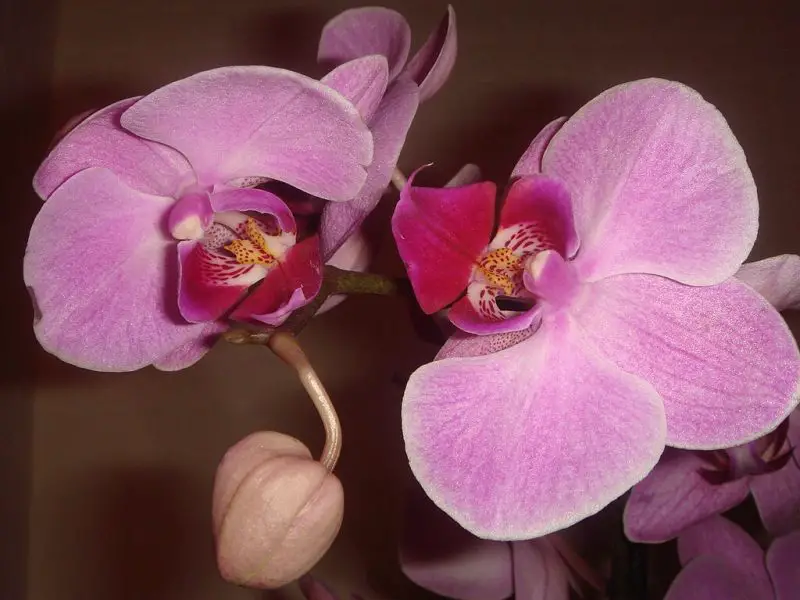
Repotting is a crucial aspect of Phalaenopsis orchid care, ensuring the health of the plant and promoting future growth.
In this section, we’ll discuss the signs that indicate it’s time to repot and provide a step-by-step guide to the repotting process.
Signs It’s Time to Repot
- Root Health: If the roots are overflowing the pot or appear cramped, it’s time for a larger space.
- Potting Medium: If the potting medium has broken down and become compacted, it can lead to poor drainage and root health.
- Plant Growth: If the orchid has grown significantly and is top-heavy or unstable in its pot, it needs more room.
- Health Issues: If you notice signs of root rot or other health problems, repotting can help address these issues.
Step-by-Step Repotting Process
- Choose the Right Time: The best time to repot is after the orchid has finished blooming, and new growth is beginning.
- Prepare Materials: Gather a new pot (only slightly larger than the current one), fresh orchid potting mix, and sterilized pruning tools.
- Remove the Orchid: Gently remove the orchid from its current pot, being careful not to damage the roots.
- Clean the Roots: Trim away any dead or rotting roots with sterilized scissors or pruning shears. Rinse the remaining healthy roots with lukewarm water.
- Prepare the New Pot: Place a layer of orchid potting mix at the bottom of the new pot.
- Position the Orchid: Place the orchid in the new pot, spreading out the roots gently. Fill in around the roots with fresh potting mix, tapping the pot to settle the mix without compacting it too tightly.
- Water and Care: After repotting, water the orchid thoroughly and continue with your regular care routine. Avoid fertilizing for a few weeks to allow the roots to settle and reduce the risk of burn.
By following these steps, you can successfully repot your Phalaenopsis orchid, providing it with a fresh environment to support its continued growth and blooming.
Phalaenopsis Orchid Care FAQs
Caring for Phalaenopsis orchids can be a rewarding experience, but it often comes with a set of questions, especially for those new to orchid care.
In this section, we’ll address some of the most common questions and provide clear, concise answers to help you ensure the health and beauty of your Phalaenopsis orchids.
Q: How do you care for Phalaenopsis orchids indoors?
A: To care for Phalaenopsis orchids indoors, provide them with indirect sunlight, maintain a temperature between 65-80°F, water them once a week or when the potting mix feels dry, and keep the humidity around 50-70%.
Fertilize monthly with a balanced orchid fertilizer during the growing season.
Q: How do you keep Phalaenopsis orchids blooming?
A: To encourage blooming, ensure your orchid receives adequate light (bright, indirect sunlight), maintain consistent watering and humidity levels, and provide a slight drop in nighttime temperatures for a few weeks.
Fertilize with a bloom booster formula during the flowering season.
Q: How often do you water a Phalaenopsis orchid?
A: Water your Phalaenopsis orchid approximately once a week or when the potting mix has dried out.
Avoid overwatering, as this can lead to root rot.
The frequency may vary depending on the humidity and temperature of your environment.
Q: How long do Phalaenopsis orchids last?
A: Phalaenopsis orchids can live for many years with proper care.
Their flowers typically last 2-3 months, and with the right conditions, they can rebloom several times a year.
Q: What should I do after my Phalaenopsis is done blooming?
A: After your Phalaenopsis orchid is done blooming, cut the flower spike above the second or third node from the base to encourage a secondary bloom.
Continue regular care, and provide a rest period with reduced watering and fertilization to help the plant recover and prepare for the next blooming cycle.
Phalaenopsis Orchid Care Conclusion
In this guide, we’ve explored the essential aspects of caring for Phalaenopsis orchids.
From understanding their unique growth habits to providing the right conditions for their thriving, we’ve covered key points to help you enjoy these beautiful plants.
Let’s recap the highlights and offer some final encouragement for your orchid care journey.
Recap of Key Points
- Understanding Phalaenopsis Orchids: These orchids are known for their broad leaves, long-lasting flowers, and epiphytic growth.
- Proper Care: Regular watering, maintaining humidity, and providing indirect light are crucial.
- Fertilizing and Re-flowering: Use a balanced fertilizer and follow specific tips to encourage blooming.
- Repotting: Refresh the potting mix every 1-2 years and choose a pot that supports the orchid’s growth.
- Choosing the Right Potting Mix: Select a mix that provides adequate drainage and air circulation.
Enjoy the Beauty of Phalaenopsis Orchids
Embracing the care of Phalaenopsis orchids can bring a sense of fulfillment and beauty to your home.
Their elegant blooms and graceful presence are a reward for your dedication and attention.
Remember, every orchid has its own personality, and part of the joy is learning and adapting to its needs.
So, take pleasure in the journey, and let the enchanting beauty of Phalaenopsis orchids brighten your space and your spirit.
You can get your own Phalaenopsis Moth Orchid on Amazon
Read more: Orchid Types: Discover an Astonishing Variety of Orchids
References
To further enhance your understanding and care of Phalaenopsis orchids, we’ve compiled a list of reliable sources.
These references offer additional insights and detailed information to support your orchid-growing journey.
Whether you’re seeking specific care tips or looking to deepen your knowledge, these resources are valuable tools for any orchid enthusiast.
Care of Phalaenopsis Orchids (Moth Orchids) – University of Maryland Extension
This comprehensive guide from the University of Maryland Extension provides detailed information on the care and maintenance of Phalaenopsis orchids.
It covers topics such as watering, temperature, light requirements, and repotting, making it an excellent resource for both beginners and experienced orchid growers.
Phalaenopsis Care Sheet – Smithsonian Gardens
The Smithsonian Gardens offers a concise care sheet for Phalaenopsis orchids, highlighting key aspects of their care, including ideal environmental conditions and tips for blooming.
This resource is perfect for those looking for quick and easy-to-understand care instructions.
Novice Phalaenopsis Culture Sheet – American Orchid Society
The American Orchid Society provides a beginner-friendly culture sheet for Phalaenopsis orchids.
It covers essential care elements such as watering, light, temperature, and fertilization, offering a solid foundation for new orchid enthusiasts.
In conclusion, caring for Phalaenopsis orchids can be a rewarding experience with the right knowledge and resources.
The references provided offer valuable information to help you successfully grow and enjoy these beautiful plants.
Whether you’re a novice or an experienced grower, these resources can enhance your understanding and appreciation of Phalaenopsis orchids. Happy growing!
This post contains affiliate links.

